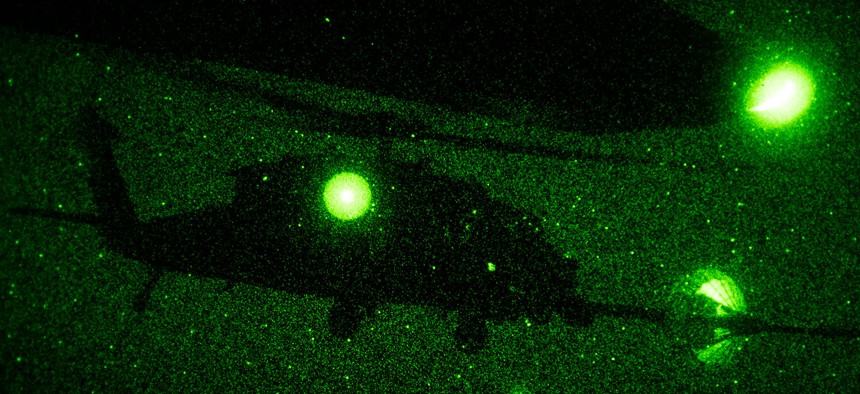
HH-60 Pavehawk from the 303rd Expeditionary Rescue Squadron, performs a night-time Helicopter Air-to-Air Refuel (HAAR) with a C-130 Hercules from the 82nd Expeditionary Rescue Squadron during a night training flight over Djibouti, Africa, March 20, 2017. United States Army
Why You Can’t Shoot Terrorists With Lasers, Yet
Military leaders are eager to have the precision of a directed-energy weapon — yet plenty of legal and practical obstacles remain.
The coalition airstrike that recently killed more than 100 civilians in Mosul underscores a familiar challenge of dense, urban warfare: how can the military more precisely hit targets from the air? Lasers represent the apogee of precision and the Pentagon has several ongoing programs that will reach readiness in the coming years. The head of Air Force Special Operations Command recently said that lasers should absolutely be “part of the discussion” about how to hit terrorists — but so should the significant legal and practical obstacles that remain.
The military already uses low-power lasers to guide its weapons, from missiles to small arms. But recent advances in solid-state fiber lasers have renewed Pentagon interest in high-energy weapons that might do the damage by themselves, firing from everything from trucks to experimental helicopter drones .
When commanders and military leaders talk about how they will use such lasers, they are careful to describe them as primarily defensive, useful for disabling enemy drones , missiles and even vehicles . Yet there is also considerable discussion about how, when, and why they might be used against enemy troops as well.
That emphasis on targeting the enemy’s stuff rather than enemy troops was the case on Wednesday. Lt. Gen. Marshall B. Webb, the head of Air Force Special Operations Command, laid out an operational scenario: pilots on a dangerous raid might use a laser mounted on an orbiting gunship to take out an enemy truck and a drone. Webb has said that he wants to test a laser aboard an AC-130J within a year .
Webb, who was speaking at the Directed Energy Summit in downtown Washington, D.C., was asked about targeting humans.
“My intent right now is to prove we can do a demo and do some specific things with this: control the beam; contain jitter,” he said.
He added that while the military still has “policy challenges” to overcome before pilots can hit human targets with lasers, “I absolutely think it should be a piece of that discussion.”
What are those policy challenges? For one, the Geneva Conventions forbid the military to use lasers to hurt people’s eyes.
“You can’t make weapon systems that are designed to damage eyes. We signed up for that,” said Mary Miller, acting assistant defense secretary for Research and Engineering.
And yet you can use lasers to temporarily blind enemies, and of course, dying is generally considered bad for vision. Miller acknowledged, somewhat, the legal ambiguity of the issue.
“The laws that I know of right now are not entirely de-laser,” she said.
The Defense Department also maintains a policy, called the Predictive Avoidance Doctrine , of not shooting lasers at things unless the trigger-puller knows exactly where that beam will end.
All this leaves enough legal room to use lasers against people — if military leaders can be more certain about the effects that the weapons would have. That means, firstly, a lot more testing.
“The deployment issue is less about the law and more about ‘Do I really believe it can do what you say?’,” said Miller.
Such assurances are not just about laser weapons’ effects on people, nor are they just for policymakers.
“It’s like, how do you make an F-22 guy feel confident that a cyber tool is going to protect him from a surface-to-air missile and he doesn’t have to react to it,” said Gen. James Holmes, who leads Air Combat Command. “How do you make [ an E-18 Growler pilot] confident that a pod on the bottom of his airplane is going to defeat a missile that’s being shot at him so he doesn’t have to maneuver against it?”
While the military has tested some directed-energy weapons against people, such as the non-lethal active denial system , the "pain ray" made famous on 60 Minutes . But a pilot or operator would probably have to keep the laser carefully trained on an enemy for longer than it would take to line up a Hellfire strike. It’s less like firing a ray gun and a bit more like killing ants with a magnifying glass.
Check out this 2014 video of the Navy using its 30-kilowatt laser against drones. Watch as the operator keeps the laser on a single spot on the drone and oncoming ship to achieve the desired effect.
That could be useful against a human target in a dense urban environment, or in a situation involving human shields, but not if the pilot is expecting an instantaneous zap and instead gets a slow fzz .
And before the Pentagon can move the world’s most exciting weapon onto planes, it must first do the boring work of writing a manual on how to use it.
“One of the things we need to do as we weaponize direct energy, we have to talk about the terms that we use so we can cooperate together,” said Holmes. “We need a joint-munitions-effectiveness manual approach … to these weapons. For a [Joint Direct Attack Munition or another smart bomb], I have a manual that tells me that: I’m going after this kind of target with this kind of airplane, I can count on success with a weapon of this size, or two of this size. We don’t have that for directed-energy weapons. So for operators to feel confident in it and use it…We have to develop that.”







